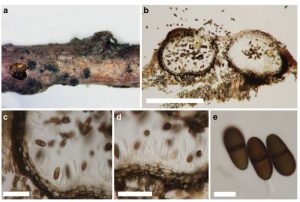Dothiorella sarmentorum (Fr.) A.J.L. Phillips, J. Luque & A. Alves, Mycologia 97: 522 (2005), Index Fungorum number: IF501403
Basionym: Sphaeria sarmentorum Fr., K. svenska Vetensk-Acad. Handl. 39: 107. 1818.
≡ Diplodia sarmentorum (Fr.) Fr., Summ. veg. Scand. (Stockholm) 2: 417. 1849.
= Diplodia pruni Fuckel, Jahrb. Nassauischen Vereins Naturk., 23–24: 169. 1870 [1869].
= Botryosphaeria sarmentorum A.J.L. Phillips, J. Luque & A. Alves, Mycologia 97: 522. 2005.
Saprobic on a wide range of hosts. Sexual morph: Undetermined on Tamarix host (see Phillips et al. 2013 for a description). Asexual morph: Conidiomata 300–440 μm high × 215–300 μm diam. (x = 376 × 250 μm, n = 5), stromatic, solitary or scattered in small groups, immersed, uniloculate, individual or aggregated, black, globose to subglobose, ostiolate. Conidiomatal wall 19–32(−45) μm (x = 37 μm, n = 15), comprising several layers; outer layers composed of thick-walled, dark brown, somewhat flattened cells of textura angularis and inner layers of larger, thin-walled, lightly pigmented or hyaline cells. Conidiophores reduced to conidiogenous cells. Conidiogenous cells 6.8–15.2 × 2.4–4.2 μm (x = 10.1 × 3.3 μm, n = 15), lining the conidiomatal cavity, holoblastic, hyaline, subcylindrical, proliferating at the same level giving rise to periclinal thickenings. Conidia 18.2–23.1 × 7.8–10.3 μm (x = 21 × 9.4 μm,n = 30), ovoid, with a broadly rounded apex and truncate base, initially hyaline to lightly pigmented and aseptate, becoming dark brown and 1-septate, slightly constricted at the septum, smooth-walled.
Culture characteristics: Conidia germinating on PDA with in 18 h and germ tubes produced from one or both cells. Colonies fast growing on PDA at 25 °C, covering the medium surface (9 cm Petri-dish) in 4 days, circular, flat, moderately dense, surface initially white, becoming greenish olivaceous to greyish within 7 days, smooth surface with entire to slightly undulate edge.
Material examined: RUSSIA, Rostov Region, Shakhty City, Central Park, on Tamarix ramosissima Ledeb. (Tamaricaceae), 16 March 2014, Timur Bulgakov 74–2 (MFLU 14–0604), living culture MFLUCC 14–0579, ICMP 20752
Notes: Phillips et al. (2005) introduced Dothiorella sarmentorum based on the asexual morph of Botryosphaeria sarmentorum. This species has a worldwide distribution and has been recorded from 34 host species (Phillips et al. 2005; Phillips et al. 2013). The sexual morph of D. sarmentorum is characterized by partially erumpent ascomata with papillate ostioles, 4–6(−8)-spored asci and oblong to ovate, (0–)1-septate, finely verruculose ascospores, widest in the middle part (Phillips et al. 2013)
FIG Dothiorella sarmentorum (MFLU 14–0604) a Appearance of conidiomata on the host b Vertical section through conidiomata c Conidiomatal wall d Conidia developing on conidiogenous cells e Mature dark brown conidia. Scale bars: b = 300 μm, c, d = 50 μm, e = 10 μm

